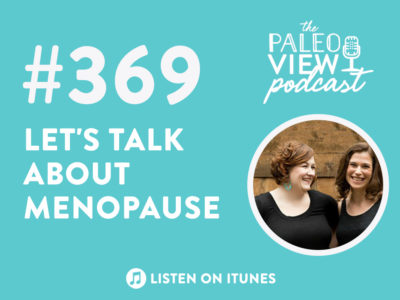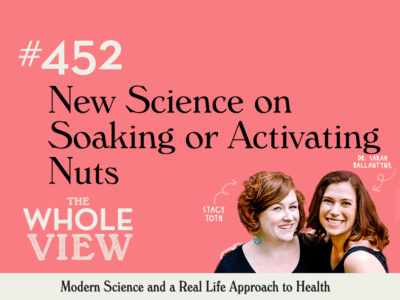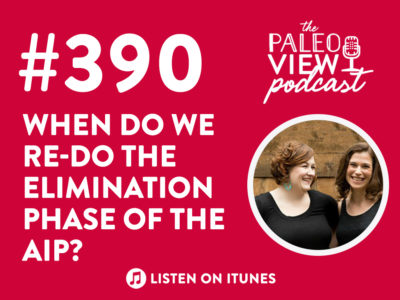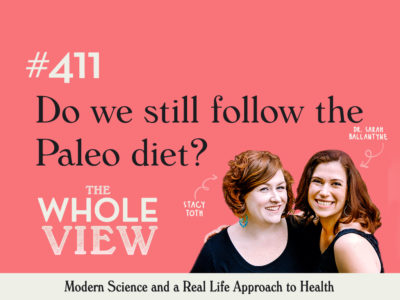On this week’s episode, Stacy and Sarah tackle a highly requested topic – menopause. What is the difference between perimenopause and menopause, what are the symptoms associated with these stages in life, and what can we do to age gracefully (i.e. enjoy the process and feel our best along the way!). Find all of this and more in episode 369!
If you enjoy the show, please review it on iTunes!
The Paleo View (TPV), Episode 369: Let’s Talk about Menopause
-
-
(0:40) Welcome
- Hey listeners – welcome back to The Paleo View!
- Stacy and Sarah geeked out over the math specialties of this episode number 369
- Sarah wished Stacy a Happy Birthday!
- Stacy talked about what happens when you get older and what she is noticing
- Today on the show, inspired by Stacy’s own aging journey, the hosts are going to talk about aging as a woman
- Specifically perimenopause and menopause
- As we get older what happens from a physical perspective
- What can we do about it from a lifestyle perspective
- Specifically perimenopause and menopause
- Stacy wants to remind people before they dive into this topic that the great think about heading into perimenopause and aging is that you are still alive
- Stacy feels like this is lost on a lot of people
- Feeling gratitude to be alive and to focus on finding your best health
- Sarah gave a shoutout to this week’s episode sponsor, EverlyWell
- Stacy and Sarah love this at-home lab testing company that offers a variety of tests, ranging from Food Sensitivity to Metabolism, to a Thyroid Test, Vitamin D to a comprehensive Women’s Health Panel
- The Paleo View listeners can use the link below to get 15% off their order with code ‘ThePaleoView’
-
(5:42) The Science
- Often the term menopause is used as this catchall
- It actually means the end of the change of life
- The time in a woman’s life when she can no longer reproduce
- It is marked by at least a year without a period
- It actually means the end of the change of life
- Perimenopause refers to that period of time that is the transition between pre-menopausal (reproductive years) and menopause (no longer reproducing)
- For most women, the transition will start sometime in their 40’s, usually late 40’s
- Some will start to notice some changes in their mid 30’s
- It can be almost instant to more than a decade in time
- Between 4 to 10 years is average
- What is happening during this period of time is that estrogen levels are starting to drop
- As estrogen drops, it can drop rapidly, and that hormone shift can cause a lot of the symptoms
- Throughout perimenopause, estrogen can cycle in a weird way
- It stops being the regular cycle that we have during our menstruation cycles
- It starts being more unpredictable
- This is what drives all the symptoms
- Symptoms:
- Hot flashes
- Sleep problems
- Vaginal dryness
- Irregular periods
- Worse PMS
- Breast tenderness
- Weight gain that isn’t linked to diet and lifestyle
- Changes to your hair
- More rapid heartbeat
- Cardiovascular disease risk factors will often increase
- Headaches
- Loss of libido
- Cognitive challenges
- Challenges conceiving
- Muscle aches
- Urinary tract infections
- Night sweats
- Fatigue
- Dry skin
- Overactive bladder or urinary incontinence
- Hyperthyroidism
- Chronic disease risk implications
- Stacy is feeling a bit of anxiety over all of the symptoms Sarah mentioned
- Stacy’s mom hasn’t gone through perimenopause yet and it is interesting to Stacy how much variability there is in one person’s experience to the next and the role that genetics play
- Sarah and Stacy discussed if/how pregnancies impact one’s menopause timeline
- When looking at this list of symptoms, Sarah wants to emphasize that some of these can be driven by stress levels and/or early perimenopause
- If you have a hormonal imbalance this is a good situation to work with a functional or integrative medicine specialist and do some hormone balancing
- These symptoms can be alleviated by balancing hormones
- Hormone balancing protocols are typically very personalized and involve tweaking hormonal doses to get them into the normal range
- The way to test is to look at the female hormones specifically
- EverlyWell does offer a very comprehensive Women’s Health panel
- Sarah’s non-medical recommendation would be to combine this with a cholesterol and lipids test
- Also measuring Vitamin D levels would be helpful to measure at this point
- Stacy recommends going back and listening to the Functional M.D. podcast episode if you are wanting to figure out how to find someone who can help you with some of these things
- Taking these tests yourself and looking at the information is going to be the best way to not just hear someone tell you that your only option is to get old and medicate
- Educate yourself with these tests and know where your inflammation markers are so that you are educated when you talk to a medical professional
- Sarah notes that the conventional medical model is symptom alleviation with prescription medications
- There are situations where women are on 8 to 10 different medications that are each for an individual symptom of menopause
- There are some really interesting studies that look at diet and lifestyle interventions and show that they are far more effective
- Given the link between nutrition and lifestyle and how easy this biological transition/tradition is that we go through, Sarah thinks that it is a real lost opportunity to educate people in terms of a healthy diet and lifestyle
- There have been studies looking at other cultures and their traditional diets
- These studies have shown that women in those cultures have a far lower rate of reporting symptoms of perimenopause
- Ex: Only 10% of women in China, 17% of women in Singapore, and 22% of women in Japan report hot flashes as part of perimenopause
- In contrast, in the US, 75% of women over the age of 50 report having hot flashes
- It does look like these diets are much higher in vegetables, fiber, lower in fat content
- There is a collection of research showing that the typical Western diet (high fat, low fiber, a lot of animal foods) can cause high estrogen levels in women
- Which means as these women enter perimenopause they are going to experience a more dramatic drop
- There have been studies now looking at vegetable and fruit consumption and menopausal symptoms
- These studies show that the higher vegetable and fruit consumption is, the fewer symptoms of menopause are experienced
- It’s inversely correlated with sugars and fats
- There is a fair amount of evidence showing that fiber is really important
- Fiber helps to bind with excess hormones and eliminate them
- So it is a very important element to hormone regulation
- These studies have shown that women in those cultures have a far lower rate of reporting symptoms of perimenopause
- There have been studies looking at other cultures and their traditional diets
- If you have a hormonal imbalance this is a good situation to work with a functional or integrative medicine specialist and do some hormone balancing
- Often the term menopause is used as this catchall
-
(36:20) The Role That Diet & Lifestyle Plays
- There is this new paradigm for understanding the symptoms of menopause where scientists are starting to make a case for them being largely driven by oxidative stress
- Oxidative stress translates to inflammation, but it means that there are a lot of oxygen radicals in the body
- Oxygen radicals in the body are not just driving inflammation, but they are also impacting cellular health
- They are impacting DNA
- Oxygen radicals are the things that cause aging
- Oxygen radicals in the body are not just driving inflammation, but they are also impacting cellular health
- One of the reasons why cruciferous vegetables are thought to be so beneficial for menopausal symptoms is because they are particularly high in antioxidants
- Oxidative stress translates to inflammation, but it means that there are a lot of oxygen radicals in the body
- The data shows that deficiency in these nutrients can magnify menopausal symptoms, it is really mixed as to whether or not supplementation can help
- It emphasizes the importance of a healthy diet going into perimenopause and maintained throughout
- Vitamin E
- Vitamin C
- Vitamin B12
- Vitamin D
- Vitamin B6
- Vitamin A
- Sarah still thinks food sources are the best sources
- Menopause increases the likelihood of B12 deficiency
- This likely drives a lot of the insomnia symptoms that are experienced in menopause
- A diet that includes organ meat, seafood and lots of plants would be the best way to structure a diet to meet these nutrient requirements that mitigate the effects of low estrogen
- Stacy’s favorite way to get the nutrients from organ meat is through liver pills
- It emphasizes the importance of a healthy diet going into perimenopause and maintained throughout
- To be completely upfront with the podcast listeners, Sarah noted that neither her nor Stacy are perfect
- They cycle in terms of what a good job they are doing in terms of diet and lifestyle
- They have both been really open about this on the show
- This is a lifestyle that does require a renewed commitment from time to time, as it is important
- Be able to recommit without guilt or blame
- Periodically we all need a reset
- One of the reasons why Sarah blogs and podcasts is to keep her accountable
- Perfection is an unachievable goal
- Stacy reminds people that the aging process happens the moment we are born
- When we can accept this process we can more easily learn how to manage the process
- Lifestyle is also really important for menopausal symptoms, especially exercise
- There is certainly a stress link and there are many recommendations in the mainstream health resources available about how to reduce stress
- Meditation
- In addition to mindfulness practices, getting enough sleep is another powerful tool when managing stress
- With sleep disturbance as a part of menopause, the way to get enough sleep is to exercise
- There have been a variety of studies that tackle this from two ways
- One: they look at women, their symptoms and how much they exercise
- Basically moderate physical activity has less than half the amount of psychological and physical symptoms of menopause than those who don’t exercise much
- High levels of physical activity is not beneficial to menopausal symptoms
- An hour(ish) a day of low to moderately intense activity is what to shoot for here
- One: they look at women, their symptoms and how much they exercise
- There is a consistent reduction in symptoms with activity over time
- One study did 50 minutes of unsupervised aerobic training, four times per week
- They saw a 2% improvement in hot flashes per week, continuously over the 6-month length of this trial
- One study did 50 minutes of unsupervised aerobic training, four times per week
- Plus there are a lot of other benefits that come with consistent exercise
- Improve bone mineral density
- Maintain muscle strength
- Improve sleep quality
- Improve mood
- Reduce anxiety and depression
- Reduce irritability
- Reduce hot flashes
- There have been a variety of studies that tackle this from two ways
- With sleep disturbance as a part of menopause, the way to get enough sleep is to exercise
- There is certainly a stress link and there are many recommendations in the mainstream health resources available about how to reduce stress
- If we take all of this, we are boiling it down to: be active and eat a lot of vegetables
- These are the two recommendations that have the strongest support in the medical literature
- Make sure cruciferous vegetables make it on the plate every day
- If you feel like you are doing all the diet and lifestyle things, but the symptoms are still really impacting your quality of life, there is definitely a time and a place for hormone replacement therapy for menopausal symptoms
- Sarah recommends workings with a Functional Integrative Medical Practitioner who has training in hormone balancing and who is going to do testing and be up to date on the literature
- Stacy gets a lot of questions around skincare for aging skin, specifically as women enter their 30’s
- This is when women’s collagen and moisture in their skin goes down
- The number one thing to keep your skin from aging is hydration and moisturization
- Also preventing oxidative stress with SPF and things like that
- Damage to our skin is caused by environmental factors, as well and genetics and all the hormones Stacy and Sarah have talked about on this show
- So you want to make sure you are addressing it from both angles if you want to reduce the signs of aging
- Hydroxy acids or fruit acids are a powerful tool
- These are widely studied as far as antiaging goes
- You can often find them listed as AHA or BHA
- This is essentially going to slough off the skin through exfoliation
- It should cause a reduction in acne, scars, and pigmentation
- Other ingredients that are helpful:
- Hyaluronic acid
- Using a moisturizer with hyaluronic acid in it is going to help maintain the moisture in your skin
- Collagen
- Stacy takes it as a supplement every day, also drinks bone broth, and eats cuts of meat that is rich in collagen
- You can increase topically your use of Vitamin C which helps synthesize collagen
- Hyaluronic acid
- Most of the antiaging skincare products out there targeted to women’s skin that is aging contain hormone-disrupting ingredients purposefully
- Before Stacy uses any products she goes to EWG and uses their Skin Deep Database
- The two things that Stacy has found the most results from are:
- Dermabrasion
- Stacy has a tutorial on this process on her Instagram stories
- Once you remove that top layer of skin, you are going to want to nourish that fresh skin
- Stacy uses BeautyCounter’s Overnight Resurfacing Peel
- This product is free through the month of September
- You can learn more here
- Dermabrasion
- Sarah uses a mix of brands that work for her skin
- However, Sarah did use the Resurfacing Peel that Stacy shared with her and was very impressed with the results
- Stacy shared on how BeautyCounter tests their products for safety
- There is this new paradigm for understanding the symptoms of menopause where scientists are starting to make a case for them being largely driven by oxidative stress
-
(1:15:27) Closing Thoughts
-
- EverylyWell offers a lot of really great testing kits for accessing that health piece
- Including addressing hormone imbalances, thyroid health, cardiovascular disease risk factors, cholesterol, vitamin D levels, and all the other things that are really important to women’s health
- You can visit this link to get 15% off your order with the ‘ThePaleoView’
- Stacy knows that this was a topic that has been highly requested by listeners, and she hopes everyone enjoyed it
- Stacy thanked Sarah for all the time she put into the research required for this show
- If you have follow up questions, Stacy and Sarah welcome them
- Please remember that neither Stacy nor Sarah are medical professionals and they cannot give listeners specific advice for your particular health issue
- However, they are happy to address things from an overall perspective
- Use the comment forms on either Stacy or Sarah’s site to submit questions
- Stacy and Sarah love to hear from listeners on social media
- Please keep tagging Stacy and Sarah when you share
- If you learned something and enjoyed the show, please be sure to share it with someone who you think could also learn from this episode
- Thanks for listening!
- EverylyWell offers a lot of really great testing kits for accessing that health piece
-
-










